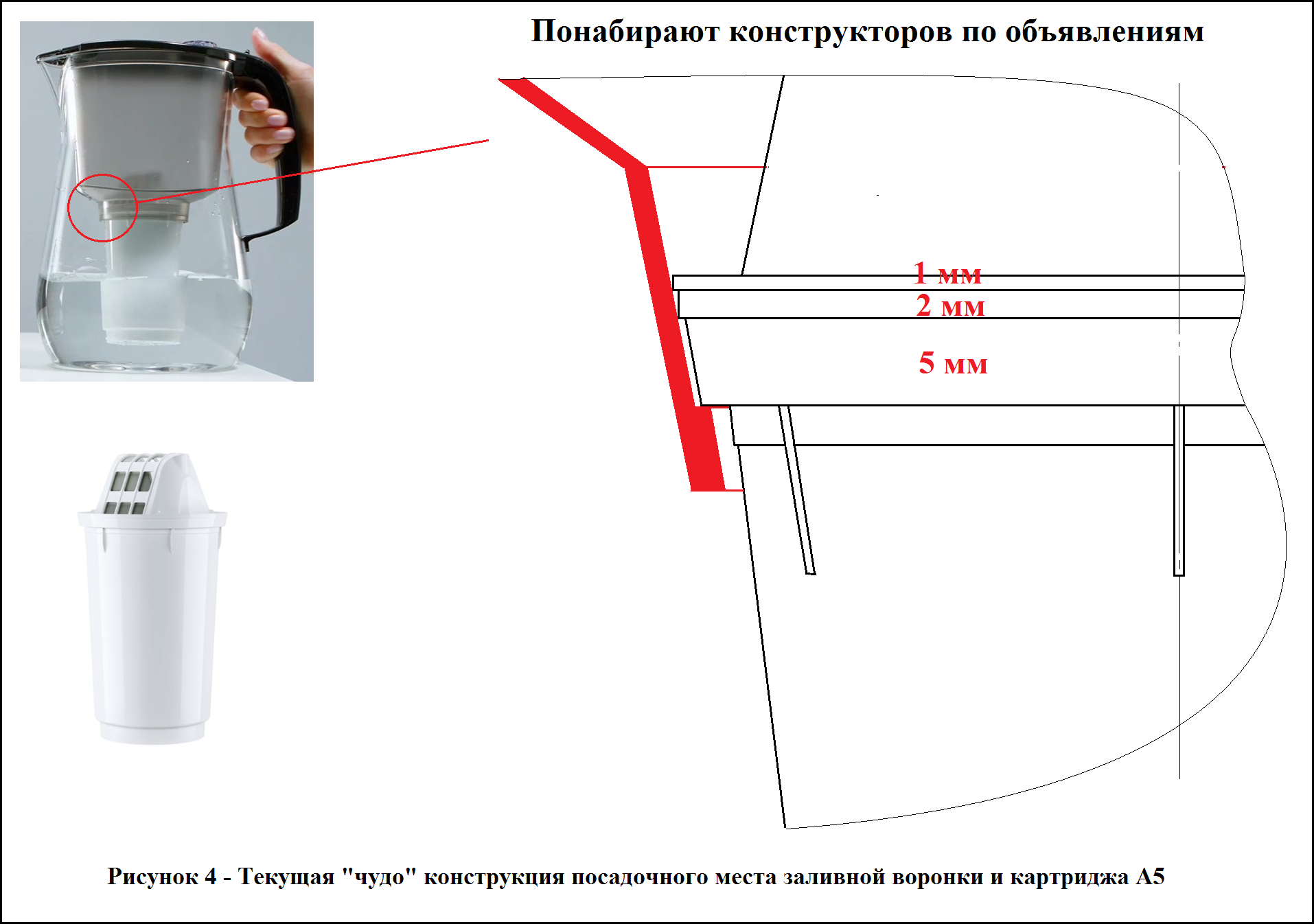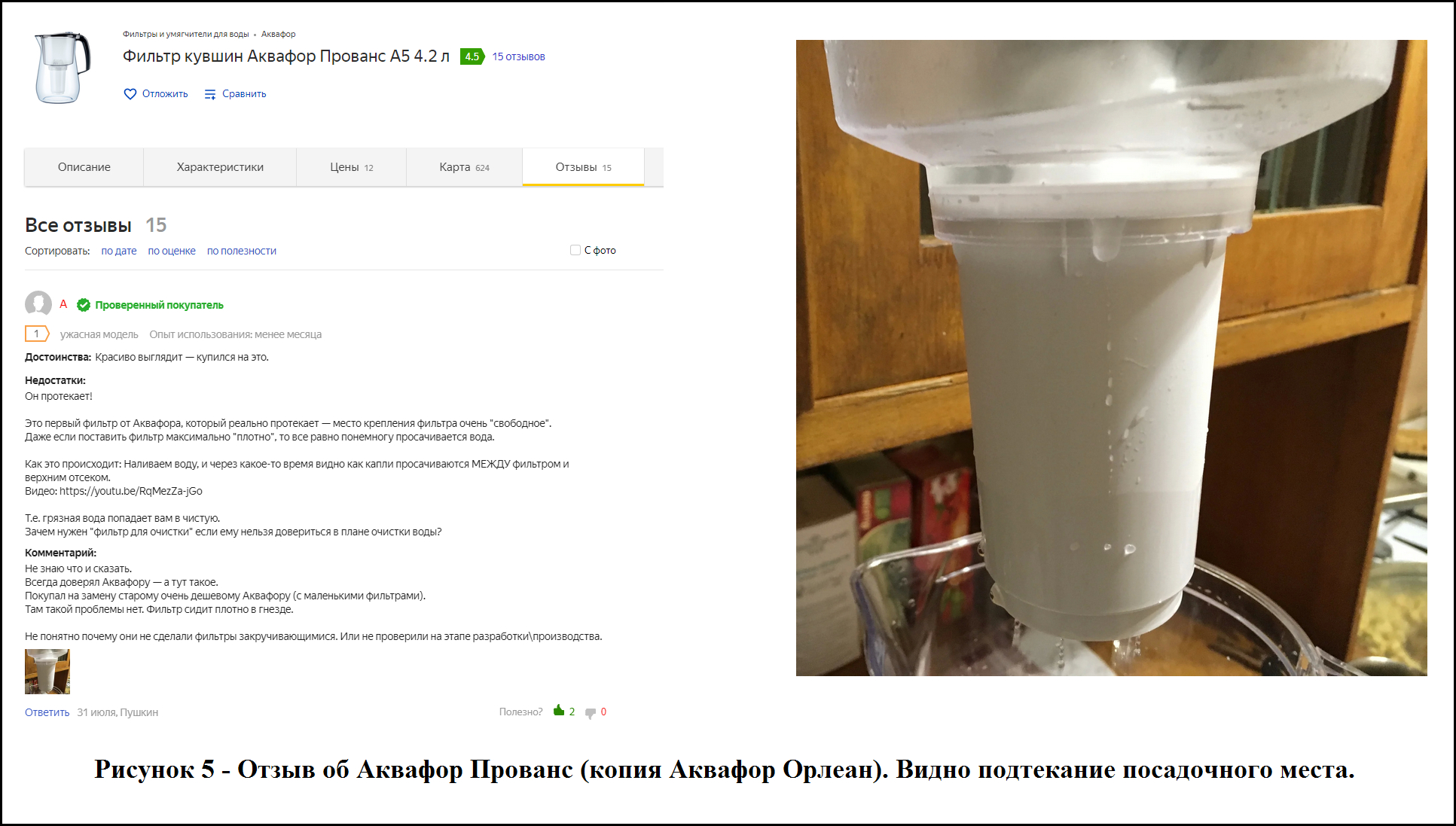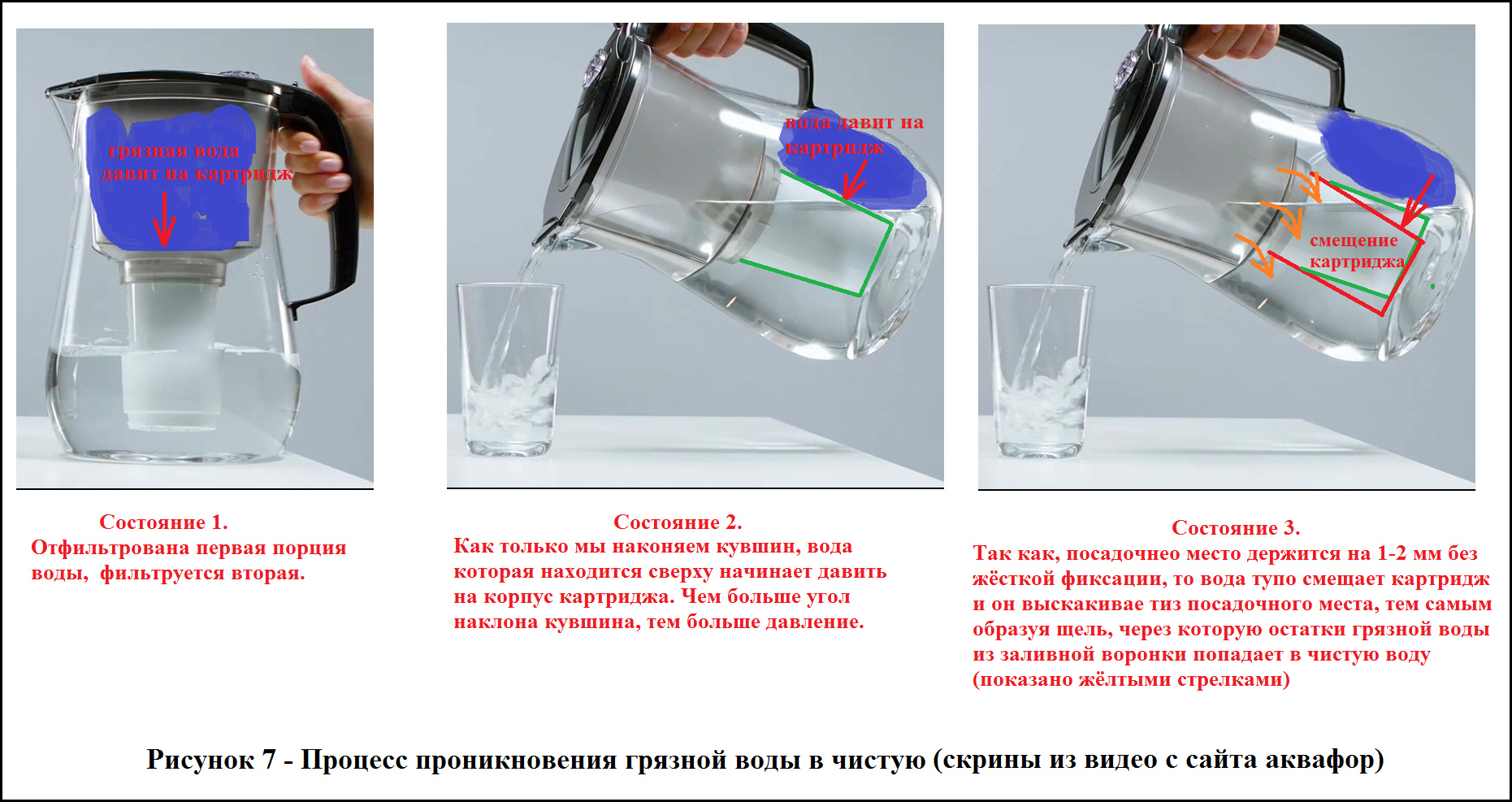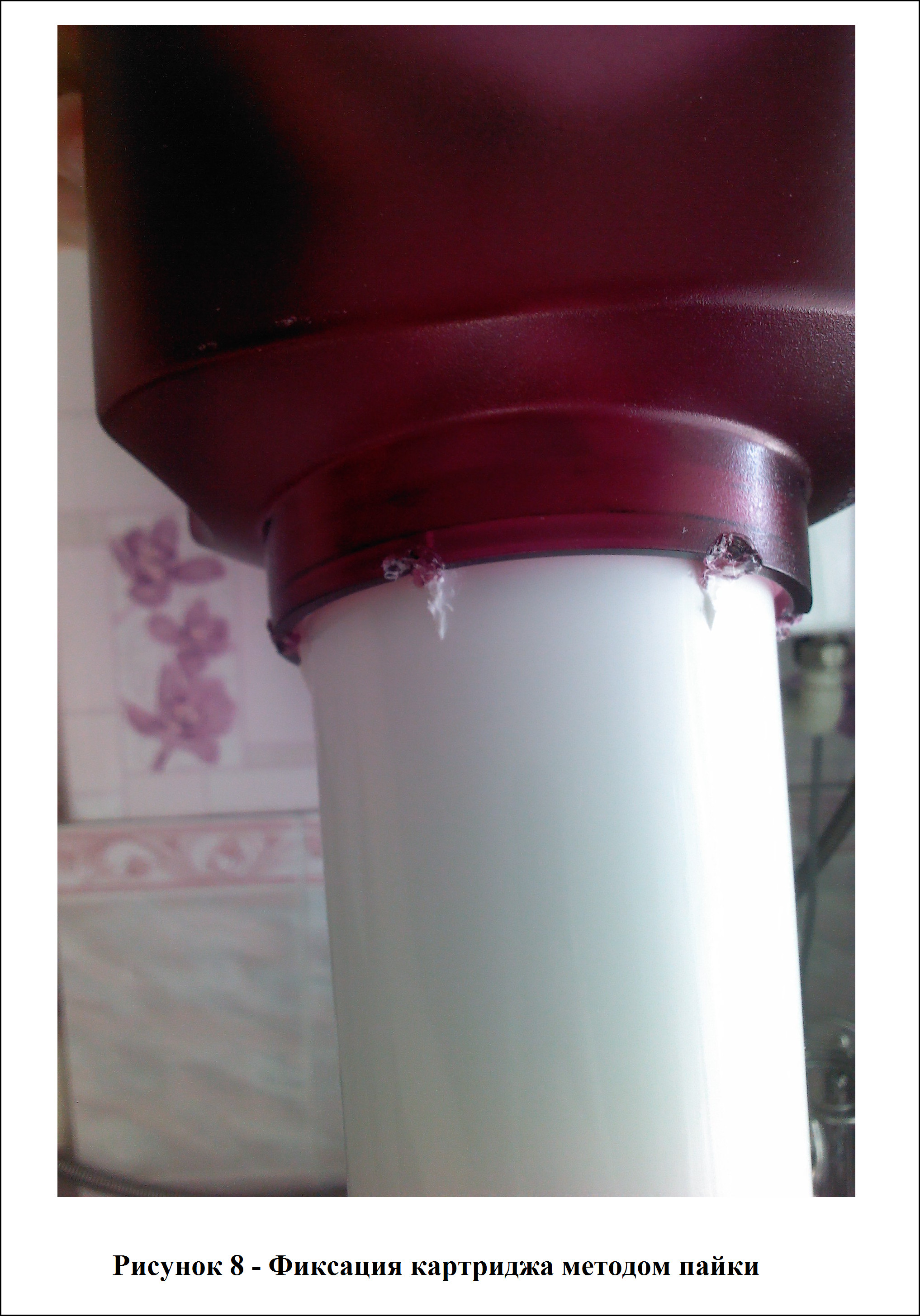Aquafor pitchers are a good example of how you cannot design filters for water treatment

There is no god. No one but ourselves will help us. From the point of view of science, man has no soul. It is not needed, everything works like that. From a scientific point of view, a person is a biorobot with a very limited resource. The brain is a hard drive storing information: basic instincts and accumulated knowledge. The heart is a blood pump. Other bodies also perform their special functions. And the main problem is that these organs wear out. And the problem is not only in limiting the basic resource of these organs, which mainly depends on the DNA and age of a person, but also in external aggressive conditions leading to premature organ failure. In my case, both kidneys did not suffer from basic aging, but from poor tap water. A couple of months ago, on my CT scan, calculi were found in both my kidneys. The main reasons for the formation of kidney stones are not very many: malnutrition and hard water. The results of a number of analyzes excluded nutrition from possible causes. As a result, in my case, there was only one reason - hard tap water. Yes, of course boiling removes part of the stiffness, but not all. A scum film constantly floats in the water, because not all of it falls out in the form of sediment to the bottom. And I drank such muck almost all my life. As a result, the urologist prescribed a course of treatment for pills / decoctions / ultrasound / dancing with tambourines, which together pulled 10,000 rubles. And it’s far from the fact that the stones will dissolve and come out in the form of sand, some types of stones do not dissolve with drugs, they require an operation to mechanically destroy them: laser, ultrasound, etc. In general, I specifically hit. But this treatment will be useless if you do not get rid of the main reason - hard water. Well, the simplest solution to the problem is to buy a water filter.
Having read a bunch of reviews / articles / tests in nete, as I already understand, most likely custom ones. After reviewing a dozen video reviews / tests, the choice fell on the filter jug Orleans, Aquaphor company . Which I actually purchased in Mvideo for 890 rubles, plus I bought a set of a pair of B6 cartridges for 459 rubles, in reserve. I brought this “miracle” home, but it does not work as it should. My disappointment knew no bounds. What praises were sung about this company: miracle cartridges with scuba do not form channels, filter blue, etc. But in practice, everything turned out to be much sadder. Yes, according to a video like this , or an article on Habré - everything looks great and works. There, the Provence jug (a copy of Orleans) is the only one who was able to completely filter out the blue. This is really impressive, just try now to pour this clean water into a teapot / glass? And you know what will happen? The remnant of blue from the filling funnel (1.2 L filling compartment) will also get into the kettle because when the jug is tilted, the A5 cartridge stupidly pops out of its seat and the remaining dirty water, through the forming gap, gets into clean water. Why is this so? Well, Aquafor company is mainly recruiting design engineers by recruiting ads without really looking at their diplomas. A detailed examination of the filter, any competent designer will say why this happens.


Firstly, the end face of the cartridge receiving dirty water is designed so that the remains of dirty water will be there anyway - a bit of dirty water always remains there. This is clearly seen in figure number 3. Not only did they make stiffeners there that prevent water from reaching the filter holes, but I also did not see a bias towards these holes. Maybe I didn’t look well, or maybe there’s no bias there.

Secondly, the design of the seat of the filling funnel and the mating surface of the cartridge A5 - are designed in violation of almost all design standards. In figure 4, this “miracle” is clearly visible. Well, the cone cannot mate with the cylinder, and even rest against the end. Plus, the neck which, in theory, should center and hold the cartridge - is only 5 mm high, although even it does not work, because the pairing generally goes higher - with a cylindrical neck of 1 ... 2 mm, where the contact surface is minimal. What kind of tightness can we talk about? Well, in the neck you need to drive such designers. If such a design were made of steel, then water would always flow past the cartridge. Fortunately, the cartridge material is made of fairly soft plastic and if you press on the end face of the cartridge with sufficient force, you can press the cartridge a bit into the seat of the filling funnel and then the cartridge will leak. Although not all of these things will help, for some it still runs: market.yandex.ru/product--filtr-kuvshin-akvafor-provans-a5-4-2-l/420071221/reviews?track=tabs&lr=54

Figure 5 shows a review of Provence, a copy of Orleans. According to all the laws of physics, it really should flow. The cone must be mated with the cone and in no case should it rest against the end of the filler funnel, thereby preventing the cartridge from falling down. This is not done. No tightness and fixation will work out that way. Conical surfaces mate with conical and do not limit obstacles. According to the laws of design, it was necessary to do at least as in figure No. 6, only in this case the cone will begin to work. Two conical surfaces themselves will find their mate. The cartridge will not fail anywhere, on the contrary, it will be centered and firmly fixed in the filling funnel and will not flow. But even this option is bad, because if you turn the filter jug upside down, the cartridge may fall out of the filling funnel (yes, the cone has the property of self-tightening, but not the fact that it was initially applied with the necessary effort to do this). However, in this case, not only the cartridge will drop out of this jug, but also the lid and the filling funnel, because they are not fixed to the body of the jug in any way. There is generally no fixation and the people who designed this miracle to see do not know what degrees of freedom are and how to deprive them. Ideally, you need to firmly fix the filler funnel to the jug body with any latches, and fix the cartridge to the filler funnel to the tapered pipe thread, well, to the kraynyak to the regular tapered thread, it will also provide sealing. What is done now is just a laugh through tears.


The fact that my water does not run past the cartridge is a direct result of the fact that I with all my strength pressed the cartridge into the seat. But this did not save me from the fact that when pouring water from the filter into the kettle, the cartridge pops up from the seat and dirty water gets into clean water. This is especially evident when the jug is full, i.e. water with a volume of two filling funnels was driven through it and pure water completely filled the lower net capacity of 2.4 liters. There, physics is simple to disgrace, everything is clearly shown in figure No. 7. In the vertical position of the jug during the filtration process, water presses on the end of the filter, deforming its body by squeezing it into the body of the filling funnel and the water does not leak, but as mentioned above, not everyone is so lucky as me. As soon as we have filtered water with a volume of two inlet funnels and begin to pour clean water into a kettle / glass, then clean water begins to put pressure on the longitudinal part of the cartridge body, which leads to the fact that it warps stupidly out of the seat of the inlet funnel forming a gap . The cartridge does not fall down into clean water - this is impossible because of the design, it stupidly skews in the seat, a gap forms and the rest of the dirty water goes into clean. And this is a normal phenomenon, because a neck with a height of 1 ... 2 mm, and even without rigid fixation, cannot reliably hold a hefty cartridge in its seat, which is also under the pressure of the weight of water. We are forced to tilt the jug to pour clean water and the larger the angle of the jug, the greater the external pressure on the longitudinal part of the cartridge body. The situation improves if we drive out only one filling funnel, i.e. we will clear 1.2 liters of water and then immediately pour clean water into a teapot / glass. Then, when pouring water, there will be no external water pressure on the cartridge, and if water is poured extremely carefully and smoothly, the cartridge will be held in the filling funnel, and dirty water will not get into clean water. But to completely pour all the clean water into the teapot / glass still does not work, because the cartridge will stay in the filling funnel only to a certain angle. And in order to pour all the water out of the filter, it will be necessary to tilt the jug quite significantly, and then the cartridge will skew again and pop out of the seat, and dirty water will fall into clean again. This is inevitable, but we filtered out only 1.2 liters of water, thereby removing the external pressure on the longitudinal body of the cartridge, but the pressure from the dead weight of the cartridge will not go anywhere. A cartridge with a large angle of inclination will still pop up - these are the laws of physics. The cartridge is not fixed at all in the seat, well, with the current design, a cylindrical neck 1 ... 2 mm high cannot hold a hefty cartridge.

I can’t understand how such a “miracle” could be launched into mass production without preliminary comprehensive tests. Well, the designer of mediocrity came across who drew this crap, but all these shortcomings should have appeared at the test stage, according to the results of which the designer had to finalize the prototype. But in fact, this "miracle" was approved and put into serial production. And if the readers of this article think that after this publication Akvafor suddenly changes his mind and quickly corrects the flaws, then I will disappoint them. Most likely nothing will happen, because it will cost decent money. This is not a single production, but mass production. It is not so easy to reconfigure it, it is tailored to a specific production special model: special dies and castings, etc. Most likely, Aquaphor will simply “score” everything, this is Russia. They have already “scored” at the design and testing stage, so they are most likely to “score” this problem as well. People have already bought a bunch of such “miracle” pitchers and they need to produce “miracle” cartridges for them, so you should not wait for changes quickly. Maybe in a few years a new series of jugs will be released with the elimination of these shortcomings, but certainly not this year. Think they don’t know that their competitor has a Barrier - a threaded cartridge mount that eliminates all of the above problems? Yes, they know very well. Just making such a design will be more complicated and costly, well, the process itself will need to be changed.
What to do to those who have already bought this “miracle”. Personally, I did as shown in figure number 8 - stupidly pointwise soldered the cartridge to the body of the filler funnel. Since I was too lazy to look for a soldering iron, I stupidly took a screwdriver and heated its tip on a gas stove. Then stupidly put a few points between the filling funnel and the stiffeners of the cartridge (so as not to break through the cartridge case itself), i.e. I grabbed the cartridge a little to the filler funnel. This must be done quite cunningly: you need to press the cartridge into the filling funnel with one hand, and grab it with the other. If the cartridge is not pressed into the funnel during the soldering process, it will flow stupidly as described above in the review of the Provence jug. As a result, I put like 6 points. As soon as the cartridge runs out of life, they can be easily torn off, because I didn’t take them very much. I see no other easy and affordable ways to solve this problem. I didn’t want to plant glue, because this fastening needed to be done in a compartment with clean water and the glue could react with water, but I did not need poisoning. Maybe there is some kind of safe eco-sealant on sale, but it was easier for me to solder. Of course, you can still draw in Compass-3D a model of your custom filling funnel, in which to fix this cartridge not by the neck of 1-2 mm, but by the large conical side of the cartridge case, then there will be a self-tightening effect, etc., you can even draw your own fastening mechanism and then print this miracle through the Internet on special sites that will send the finished part by mail. Maybe I’ll do it in the future, but as long as I live like that, such spot soldering should be enough for quite a few cartridges until the surface of the filling funnel is completely “worked out”. I just have two more B6 cartridges in stock that I bought with the filter. In general, after this soldering, I still filter only 1.2 liters of water at a time, i.e. I pour one pouring funnel and then clear water into the kettle, I do not want the weight of excess water to tear off my soldering.

In general, Aquaphor greatly disappointed me. In Yekaterinburg I somehow found him. On Yandex-cards there seems to be a branch, you come to a place, and there is nothing. You call them with a run-in “they say where is your point, how to find”, and managers stupidly do not know anything. That is, the company does not monitor the updating of information about its points of sale. I was at 4 points according to the Yandex map, in two of them I did not find Aquaphor. In 2, these were small kiosks with minimal nomenclature, i.e. the filters were in single copies standing on the windows. They had no stock of goods. And if someone bought a Provence filter in the morning, then the second buyer that day in this kiosk will not be able to buy a Provence filter, he needs to come tomorrow, or stomp to another branch. That is, their people do not really make out, there are definitely no queues for their mini kiosks. I spoke with their sellers: they did not hear about the Orleans filter at all, I wanted to visually see the differences with the Provence jug. But it’s worth going 20 meters from their kiosk to the neighboring MVideo pavilion and Orleans is standing there. In general, Barrier and Brita filters are more common in Yekaterinburg. As a result, I bought Orleans and an additional set of 2 B6 filters in MVideo, now I'm sorry. I wanted to get the finished product, but I got the semi-finished product, which had to be finalized by soldering. In my opinion, Aquafor are amateurs, though their competitors are no better. Judging by the reviews, the Barrier began to produce cartridges with less filtering content, and Brita was less expensive. As for the Geyser, not everything is so smooth either. By the way, Aquaphor cartridges are also not all so effective in terms of filler, judging by the site’s control, the B8 cartridge lost to the Barrier Ultra cartridge, although the latter filters the liter for a very long time from 12 to 15 minutes. In general, the whole campaign does not care about the consumer - the main thing is to cut the dough. In general, the problems described by me in this article cover not only Orleans and Provence jugs, but all jug filters with a landing diameter of 7 cm, i.e. for cartridges A5, B5, A6, B6, etc. Akvafor also has jugs of reduced size for cartridges with diameters of 5 cm, and judging by the reviews they do not seem to run, but it can easily happen that those reviews are custom-made. So think with your head whether it is worth buying Aquafor products. Maybe their other systems are well designed: flow filters, reverse osmosis? Perhaps so, but I doubt it very much, because as a rule all design work is done by one design department. That is, if their designers did not have the brains to soundly make a banal jug, then will they be able to do more complex things well? In general, think for yourself what to buy. Just do not drink bad water - use filters. Or buy bottled water, if of course there is such an opportunity. And do not trust reviews and articles. Good luck!
All Articles